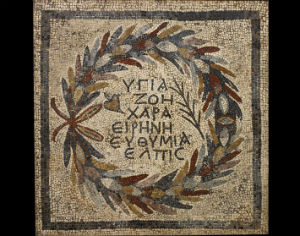University to partner with British Museum to develop new collection storage and research facility
01 December 2017

The University of Reading is partnering with the British Museum to develop a significant new collection storage and research facility.
This would be a first of its kind partnership between a national museum and a UK university to deliver study and research benefits to students, academics and members of the public.
The British Museum Archaeological Research Collection would provide storage for the Museum's important research collections. Objects would include sculptures from across the ancient world, historic casts of ancient sculpted material and important archaeological assemblages and collections from Britain and across the world.
The new development would not be a second British Museum but study rooms would give University students, academics and members of the public access to the collections for study and research. In addition, the Museum plans to work closely with local museums to lend objects from the study collection.
Subject to planning permission, the British Museum and the University of Reading hope to locate the storage facility next to the Thames Valley Science Park, which is located within Wokingham Borough.
Discussions around the look and feel of the proposed development are at a very early stage and talks with officers at Wokingham Borough Council are ongoing. Subject to these discussions, the University and the British Museum will engage the community in a broader public consultation in the New Year before any planning application is submitted to Wokingham Borough Council. Should the planning application be successful it is anticipated that the facility could be complete in time to allow objects from Blythe House to be moved by the end of March 2023, when the Government is due to sell the building.
Vice-Chancellor of the University of Reading, Sir David Bell, said: "We are delighted to be partnering with the British Museum to develop this important storage and research facility. The University has an impressive collection of museums so this partnership is a natural extension of our work that will benefit not only our students and academics, but the local community and beyond."
Hartwig Fischer, Director of the British Museum said: "This is a hugely exciting project for the British Museum and will be a cornerstone of the Museums masterplan. I am delighted we are partnering with the University of Reading on the project. The Museum's study is of incomparable research value and the facility will ensure more access to the collection for study and loans, fulfilling two of the central purposes of the British Museum."
John Glen, Minister for Arts, Heritage and Tourism, said: "This is a really exciting partnership that will give researchers, academics and other institutions more access to the British Museum's incredible Blythe House collection.
"Blythe House is a treasure trove of historic artefacts and we are investing £150 million to help museums create new world-class facilities to protect and preserve this unique and important collection."
The University of Reading is already an important research partner of the British Museum, with major ground-breaking research projects based on the Museum's archaeological collections. This includes a Reading-led study of excavated prehistoric grave goods to better explain the role of objects in the lives of people living in ancient Britain. This project will underpin a new interpretation of the displays by 2020 in the Museum's public gallery Europe and the Middle East, 10,000BC to 800BC. The Museum has also worked with Reading on a joint programme of collaborative PhD studentships. Reading offers a strong range of teaching and research programmes with direct relevance to areas of the British Museum collection - from Palaeolithic prehistory to later world archaeology and history.
The University of Reading owns three museums:
In addition, the University's Museums and Special Collections Services brings together the University's collections of rare books, archives and manuscripts.
A current exhibition, a collaboration between The Ure Museum of Greek Archaeology and Special Collections, features an artefact on loan from the British Museum. The original slate mould carved by nineteenth-century neoclassical artist and craftsman for his miniaturized cast of a section of the Parthenon Frieze forms part of the exhibition ‘From Italy to Britain: Winckelmann and the spread of neoclassical taste’, which tells the story of Johann Joachim Winckelmann’s contribution to the revival of classical arts and culture in Britain in the 18th and 19th centuries. The exhibition runs until 15 December 2017.
